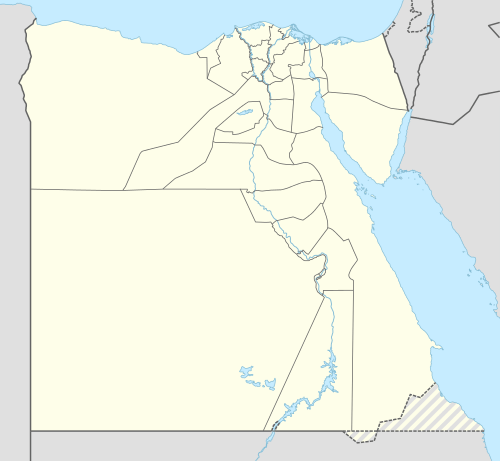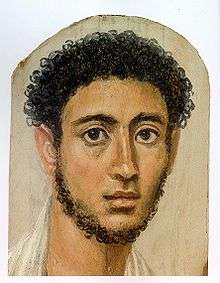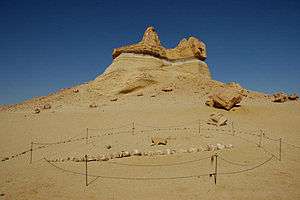Faiyum
| Faiyum الفيوم | |
|---|---|
 Faiyum Location in Egypt | |
| Coordinates: 29°18′30″N 30°50′39″E / 29.308374°N 30.844105°ECoordinates: 29°18′30″N 30°50′39″E / 29.308374°N 30.844105°E | |
| Country |
|
| Governorate | Faiyum |
| Elevation | 23 m (75 ft) |
| Population (2012) | |
| • Total | 349,883 |
| Time zone | EET (UTC+2) |
Faiyum[1] (Arabic: الفيوم El Fayyūm pronounced [elfæjˈjuːm]; Coptic: ̀Ⲫⲓⲟⲙ Phiom) is a city in Middle Egypt. Located 100 kilometres (62 miles) southwest of Cairo, in the Faiyum Oasis, it is the capital of the modern Faiyum Governorate. Originally called Shedet in Ancient Egypt, the Greeks called it Crocodilopolis or Krocodilopolis, the Romans Arsinoë.[2] It is one of Egypt's oldest cities due to its strategic location.[2]
Name and etymology
| |||||||
| pꜣ-ymꜥ in hieroglyphs |
|---|
Its name in English is also spelled as Fayum, Faiyum or El Faiyūm. Faiyum was previously officially named Madīnet El Faiyūm (Arabic for The City of Faiyum). The name Faiyum (and its spelling variations) may also refer to the Faiyum Oasis, although it is commonly used by Egyptians today to refer to the city.[3][4]
The modern name of the city comes from Coptic ̀Ⲫⲓⲟⲙ /Ⲡⲉⲓⲟⲙ epʰiom/peiom (whence the proper name Ⲡⲁⲓⲟⲙ payom), meaning the Sea or the Lake, which in turn comes from late Egyptian pꜣ-ymꜥ of the same meaning, a reference to the nearby Lake Moeris; the extinct elephant ancestor Phiomia was named after it.
Ancient history

Archaeological evidence has found occupations around the Fayum dating back to at least the Epipalaeolithic period. The middle Holocene occupations of the area are most widely studied on the north shore of Lake Qarun, where Caton-Thompson and Gardner did a number of excavations of Epipalaeolithic and Neolithic sites, as well as a general survey of the area.[5] Recently the area has been further investigated by a team from the UCLA/RUG/UOA Fayum Project.[6][7]
In the Pharaonic era, the city now called Medinet el Fayum (City of Faiyum) was called Shedet. It was the most significant centre of the cult of Sobek, the crocodile-god. In consequence, the Greeks named it Crocodilopolis, "Crocodile City", from the particular reverence paid by its inhabitants to crocodiles. The city worshipped a tamed sacred crocodile, named Petsuchos, that was adorned with gold and gem pendants. The crocodile lived in a special temple pond and was fed by the priests with food provided by visitors. When the Petsuchos died, it was replaced by another.[8][9]
Under the Ptolemies, the city was for a while called Ptolemais Euergetis.[10] Ptolemy II Philadelphus (309–246 BC) rechristened the city Arsinoë and the whole nome after the name of his sister and wife Arsinoë (316–270 or 268), whom he deified after her death, if not before.[11]
Under the Roman Empire, Arsinoe became part of the province of Arcadia Aegypti. To distinguish it from other cities of the same name, it was called Arsinoë in Arcadia.
With the arrival of Christianity, Arsinoe became the seat of a bishopric, a suffragan of the Oxyrhynchus, the capital of the province and the metropolitan see. Lequien gives the names of several bishops of Arsinoe, nearly all of them associated with one heresy or another.[12]
The Catholic Church, considering Arsinoë in Arcadia to be no longer a residential bishopric, lists it as a titular see.[13]
Modern city
Faiyum has several large bazaars, mosques,[14] baths and a much-frequented weekly market. The canal called Bahr Yussef runs through the city, its banks lined with houses. There are two bridges over the river: one of three arches, which carries the main street and bazaar, and one of two arches, over which is built the Qaitbay mosque, that was a gift from his wife to honor the Mamluk Sultan in Fayoum. Mounds north of the city mark the site of Arsinoe, known to the ancient Greeks as Crocodilopolis, where in ancient times the sacred crocodile kept in Lake Moeris was worshipped.[15] The center of the city is on the canal, with the four waterwheels, that are adopted by the governorate of Fayoum as its national symbol; their chariots and bazaars are easy to spot.
Faiyum mummy portraits

Faiyum is the source of some famous death masks or mummy portraits painted during the Roman occupation of the area. The Egyptians continued their practice of burying their dead, despite the Roman preference for cremation. While under the control of the Roman Empire, Egyptian death masks were painted on wood in a pigmented wax technique called encaustic—the Faiyum mummy portraits represent this technique.[16] Modern Studies conclude that the Faiyum portraits represent Greek settlers in Egypt.[17][18] Victor J. Katz notes that "most modern studies conclude that the Greek & Egyptian communities coexisted with little mutual influence".[19] Anthony Lowsted has written extensively on the scope of Apartheid that separated the 2 communities during the Hellenistic, Roman & Byzantine period. [20]
Main sights
- Hanging Mosque, built under the Ottoman Rule over Egypt
- Hawara, archeological site 27 km (17 mi) from the city
- Lahun Pyramids, 4 km (2 mi) outside the city
- Qaitbay Mosque, in the city, and was built by the wife of the Mamluk Sultan Qaitbay
- Qasr Qarun, 44 km (27 mi) from the city
- Wadi Elrayan or Wadi Rayan, the largest waterfalls in Egypt, around 50 km (31 mi) from the city
- Wadi Al-Hitan or Valley of whales, a paleontological site in the Al Fayyum Governorate, some 150 km (93 mi) southwest of Cairo. It is a UNESCO World Heritage Site.
Climate
Köppen-Geiger climate classification system classifies its climate as hot desert (BWh).
The highest record temperatures was 46 °C (115 °F) on June 13, 1965 and the lowest record temperature was 2 °C (36 °F) on January 8, 1966.[21]
| Climate data for Faiyum | |||||||||||||
|---|---|---|---|---|---|---|---|---|---|---|---|---|---|
| Month | Jan | Feb | Mar | Apr | May | Jun | Jul | Aug | Sep | Oct | Nov | Dec | Year |
| Record high °C (°F) | 28 (82) |
30 (86) |
36 (97) |
41 (106) |
43 (109) |
46 (115) |
41 (106) |
43 (109) |
39 (102) |
40 (104) |
36 (97) |
30 (86) |
46 (115) |
| Average high °C (°F) | 18.9 (66) |
20.9 (69.6) |
24.1 (75.4) |
29 (84) |
33.6 (92.5) |
35.5 (95.9) |
36.1 (97) |
35.8 (96.4) |
33.2 (91.8) |
30.7 (87.3) |
25.7 (78.3) |
20.4 (68.7) |
28.66 (83.57) |
| Daily mean °C (°F) | 11.6 (52.9) |
13.2 (55.8) |
16.1 (61) |
20.4 (68.7) |
24.9 (76.8) |
27.1 (80.8) |
28.2 (82.8) |
28.1 (82.6) |
25.7 (78.3) |
23.1 (73.6) |
18.6 (65.5) |
13.5 (56.3) |
20.87 (69.59) |
| Average low °C (°F) | 4.3 (39.7) |
5.5 (41.9) |
8.2 (46.8) |
11.8 (53.2) |
16.3 (61.3) |
18.8 (65.8) |
20.3 (68.5) |
20.4 (68.7) |
18.2 (64.8) |
15.6 (60.1) |
11.6 (52.9) |
6.6 (43.9) |
13.13 (55.63) |
| Record low °C (°F) | 2 (36) |
4 (39) |
5 (41) |
8 (46) |
11 (52) |
16 (61) |
13 (55) |
13 (55) |
10 (50) |
11 (52) |
4 (39) |
4 (39) |
2 (36) |
| Average precipitation mm (inches) | 1 (0.04) |
1 (0.04) |
1 (0.04) |
1 (0.04) |
0 (0) |
0 (0) |
0 (0) |
0 (0) |
0 (0) |
0 (0) |
1 (0.04) |
2 (0.08) |
7 (0.28) |
| Source #1: Climate-Data.org[22] | |||||||||||||
| Source #2: Voodoo Skies[21] for record temperatures | |||||||||||||
Notable people
- Tefta Tashko-Koço, well known Albanian singer was born in Faiyum, where her family lived at that time.
- Saadia Gaon, the influential Jewish teacher of the early 10th century, was originally from Faiyum, and often called al-Fayyumi.
- Youssef Wahbi, a notable Egyptian actor, well known for his influence on the development of Egyptian cinema and theater.
Gallery
-

Qarun Palace
-

Temple
-

A whale skeleton lies in the sand at Wadi Al-Hitan (Arabic: وادي الحيتان, "Whales Valley") near the city of Faiyum
See also
- Bahr Yussef
- Book of the Faiyum
- Fayum alphabet
- Faiyum Governorate
- Faiyum mummy portraits
- Lake Moeris
- Phiomia (an extinct relative of the elephant, named after Faiyum)
- Nash Papyrus
- Roman Egypt
- Wadi Elrayan
References
- ↑ https://www.lonelyplanet.com/egypt/medinat-al-fayoum
- 1 2 Paola Davoli (2012). "The Archaeology of the Fayum". In Riggs, Christina. The Oxford Handbook of Roman Egypt. Oxford University Press. pp. 152–153153. ISBN 9780199571451.
- ↑ "The name of the Fayum province. Katholieke Universiteit Leuven". Trismegistos.org. Retrieved 2013-01-15.
- ↑ "Faiyum. Eternal Egypt". Eternalegypt.org. Retrieved 2013-01-15.
- ↑ Caton-Thompson, G. and Gardner, E. (1934). The Desert Fayum. London: Royal Anthropological Institute of Great Britain and Ireland.
- ↑ Holdaway, Simon; Phillipps, Rebecca; Emmitt, Joshua; Wendrich, Willeke (2016-07-29). "The Fayum revisited: Reconsidering the role of the Neolithic package, Fayum north shore, Egypt". Quaternary International. The Neolithic from the Sahara to the Southern Mediterranean Coast: A review of the most Recent Research. 410, Part A: 173–180. doi:10.1016/j.quaint.2015.11.072.
- ↑ Phillipps, Rebecca; Holdaway, Simon; Ramsay, Rebecca; Emmitt, Joshua; Wendrich, Willeke; Linseele, Veerle (2016-05-18). "Lake Level Changes, Lake Edge Basins and the Paleoenvironment of the Fayum North Shore, Egypt, during the Early to Mid-Holocene". Open Quaternary. 2 (0). doi:10.5334/oq.19. ISSN 2055-298X.
- ↑ Thomas Joseph Pettigrew, A History of Egyptian Mummies (Longman 1834), pp. 211–213
- ↑ Margaret Bunson, Encyclopedia of Ancient Egypt (Infobase Publishing 2009 ISBN 978-1-43810997-8), p. 90
- ↑ Simon Hornblower, Antony Spawforth, Esther Eidenow (editors), The Oxford Classical Dictionary (Oxford University Press 2012 ISBN 978-0-19954556-8), p. 171
- ↑ Philippe Guillaume, Ptolemy the second Philadelphus and his world (BRILL 2008 ISBN 978-90-0417089-6), p. 299
- ↑ Michel Lequien, Oriens christianus in quatuor Patriarchatus digestus, Paris 1740, Vol. II, coll. 581-584
- ↑ Annuario Pontificio 2013 (Libreria Editrice Vaticana 2013 ISBN 978-88-209-9070-1), p. 840
- ↑ The Mosque of Qaitbey in the Fayoum of Egypt by Seif Kamel
- ↑ "The Temple and the Gods, The Cult of the Crocodile". Umich.edu. Retrieved 2013-01-15.
- ↑ "History of Encaustic Art". Encaustic.ca. 2012-06-10. Retrieved 2013-01-15.
- ↑ Egyptology Online: Fayoum mummy portraits accessed on January 16, 2007
- ↑ Encyclopædia Britannica Online - Egyptian art and architecture - Greco-Roman Egypt accessed on January 16, 2007
- ↑ Victor J. Katz (1998). A History of Mathematics: An Introduction, p. 184. Addison Wesley, ISBN 0-321-01618-1: "But what we really want to know is to what extent the Alexandrian mathematicians of the period from the first to the fifth centuries C.E. were Greek. Certainly, all of them wrote in Greek and were part of the Greek intellectual community of Alexandria. And most modern studies conclude that the Greek community coexisted with little mutual influence. So should we assume that Ptolemy and Diophantus, Pappus and Hypatia were ethnically Greek, that their ancestors had come from Greece at some point in the past but had remained effectively isolated from the Egyptians? It is, of course, impossible to answer this question definitively. But research in papyri dating from the early centuries of the common era demonstrates that a significant amount of intermarriage took place between the Greek and Egyptian communities chiefly Greek men taking Egyptian wives. And it is known that Greek marriage contracts increasingly came to resemble Egyptian ones. In addition, even from the founding of Alexandria, small numbers of Egyptians were admitted to the privileged classes in the city to fulfill numerous civic roles. Of course, it was essential in such cases for the Egyptians to become "Hellenized," to adopt Greek habits and the Greek language. Given that the Alexandrian mathematicians mentioned here were active several hundred years after the founding of the city, it would seem at least equally possible that they were ethnically Egyptian as that they remained ethnically Greek. In any case, it is unreasonable to portray them with purely European features when no physical descriptions exist."
- ↑ Anthony Lowsted (2014). Apartheid Ancient, Past, and Present Gross Racist Human Rights Violations in Graeco-Roman Egypt, South Africa, Israel/Palestine and Beyond http://www.bacbi.be/pdf/apartheid-2014.pdf
- 1 2 "El Fayoum, Egypt". Voodoo Skies. Retrieved 17 July 2013.
- ↑ "Climate: Faiyum - Climate graph, Temperature graph, Climate table". Climate-Data.org. Retrieved 17 August 2013.
External links
| Wikinews has related news: 30 brightly coloured mummies discovered in Egyptian necropolis |
| Wikimedia Commons has media related to Faiyum. |
| Wikivoyage has a travel guide for Faiyum. |
- "Photo Gallery: Water Issues in Fayoum Villages".
- Falling Rain Genomics, Inc. "Geographical information on Al Fayyum, Egypt". Retrieved 2011-03-22.
- Fayum towns and their papyri, edited with translations and notes by Bernard P. Grenfell and Arthur S. Hunt at the Internet Archive
- Vincent L. Morgan and Spencer G. Lucas (2002). "Notes From Diary––Fayum Trip, 1907" (PDF). Bulletin 22. Albuquerque: New Mexico Museum of Natural History and Science. 148 pages, public domain. ISSN 1524-4156. External link in
|publisher=(help) - Fayoum Photo Gallery

